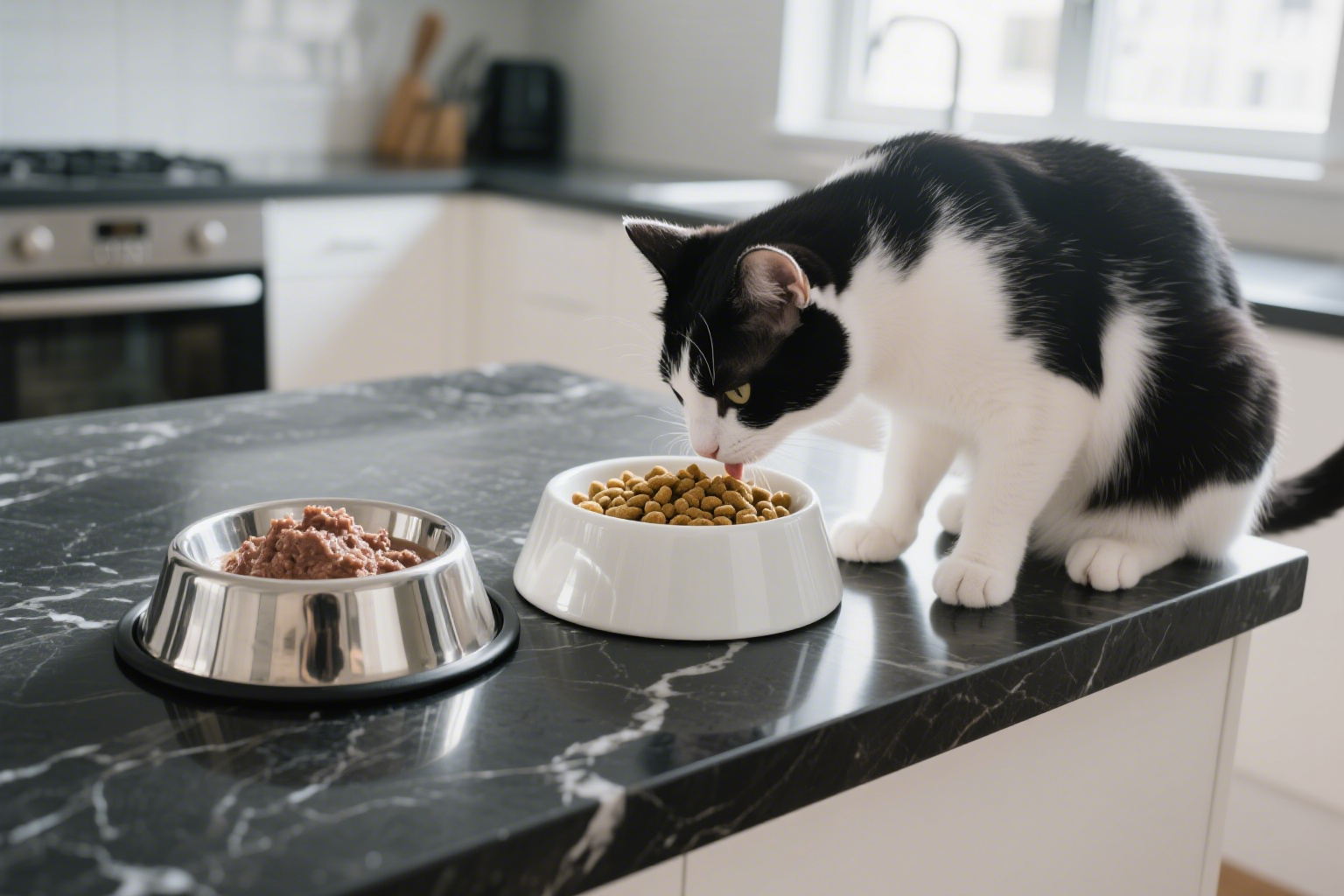
Living in an apartment means every choice you make for your cat is deliberate and impactful. You’ve researched the quietest toys, the most space-efficient cat tree, and now you face the most polarizing decision in the pet food aisle: wet vs. dry cat food?
This single choice is surrounded by myths, strong opinions, and clever marketing. But for your apartment cat’s health, cutting through the noise to find the honest truth is crucial. We’re not just talking about preference; we’re talking about long-term wellness. Let’s dissect this debate, piece by piece.
Table of Contents
The #1 Factor: Hydration, Hydration, Hydration
This is the most critical point and the single biggest argument in the wet vs dry cat food debate. Cats are biologically designed to get moisture from their food. Their wild ancestors hunted prey like mice and birds, which are about 70% water. This genetic blueprint means cats have a naturally low thirst drive. They simply don’t feel thirsty until they are already partially dehydrated.
When you feed your cat a diet of dry kibble, they are only consuming about 10% moisture from their meals. To compensate, they would need to drink a significant amount of water. Most cats will never drink enough to truly make up this deficit, putting them in a constant state of low-level dehydration. Wet food, containing around 75% moisture, elegantly solves this problem by providing hydration while they eat. For promoting a healthy urinary tract and preventing kidney issues, this single factor makes a world of difference.
The Weighty Issue: Managing an Apartment Cat’s Figure
Weight management is a primary concern for the indoor apartment cat. A less active, indoor lifestyle can easily lead to obesity, which opens the door to a host of health problems like diabetes and arthritis. When considering if is wet food better for cats in this context, the nutritional panel tells a compelling story.
High-quality wet food is typically higher in protein and lower in carbohydrates. Protein is essential for maintaining lean muscle mass, while excessive carbs can be stored as fat. Dry kibble, by its nature, requires more carbohydrates and starches to hold its shape. Furthermore, wet food provides built-in portion control. It’s much harder to overfeed with distinct meal times using cans or pouches than it is to “free-feed” with a constantly refilled bowl of calorie-dense kibble, which is a common habit for busy owners.
The Myth of the ‘Crunch’: Does Kibble Really Clean Teeth?
For decades, a key marketing point for dry food has been that its crunchy texture helps scrape away tartar and clean teeth. This sounds logical, but for most cats, it’s a deeply ingrained myth.
Think of it like this: does eating a handful of crackers clean your teeth? Not really. Many cats swallow their kibble whole. Even when they do crunch, the kibble shatters instantly, providing minimal abrasive action against the tooth surface, especially near the gum line where tartar accumulates. While specially designed “dental diet” kibbles do exist and are larger and more effective, standard dry food offers negligible dental benefits. The gold standard for your apartment cat’s health and dental hygiene remains the same as for humans: regular brushing and professional cleanings.
The Case for Kibble: Convenience, Cost, and… Fun!
So, is dry food useless? Absolutely not. It has its place, and denying its advantages would be dishonest.
- Convenience & Budget: Kibble is undeniably more affordable, easier to store, and less messy to serve. For apartment dwellers with limited space and busy schedules, this is a significant benefit.
- Enrichment Tool: This is where kibble truly shines for an indoor cat! It’s the perfect fuel for food puzzles and interactive toys. Using kibble this way turns mealtime into a stimulating “hunt,” fighting boredom and encouraging natural foraging instincts.
The Perfect Compromise: Embracing a Mixed-Feeding Routine
You don’t have to choose a side. In fact, for many modern cat owners, the optimal solution is a hybrid approach. A mixed-feeding routine allows you to leverage the benefits of both food types.
A great routine could be serving a portion of high-protein, high-moisture wet food for breakfast and dinner. This covers their primary hydration and nutritional needs. During the day, while you’re at work or busy, you can leave a small, measured amount of kibble in a food puzzle. This strategy provides essential hydration, manages calorie intake, and offers crucial mental stimulation, ticking all the boxes for a happy and healthy indoor cat.
The Verdict: Your Final Answer in the Wet vs. Dry Debate
After weighing the honest truth, the verdict is clear: wet food should be the foundation of your cat’s diet. Its benefits for hydration and weight control are simply too significant to ignore, directly impacting your apartment cat’s health in the long term.
Dry food is not the enemy, but its role should be redefined. Think of it less as a “meal” and more as a “tool”—a budget-friendly supplement and a fantastic enrichment device. By prioritizing wet food and using kibble strategically, you are making the most informed, balanced, and loving choice for your urban feline companion.